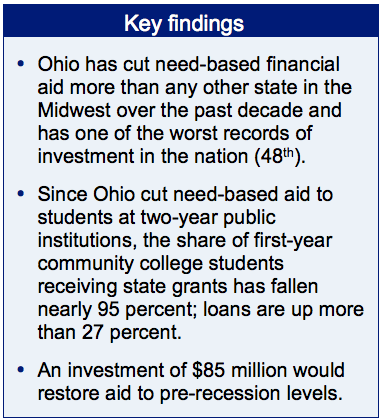
Kasich Tax Plan: Advantage, Top 1 Percent
March 14, 2014
Kasich Tax Plan: Advantage, Top 1 Percent
March 14, 2014
For immediate releaseContact Zach Schiller, 216.361.9801Download Brief (4pp)Gov. John Kasich’s new tax proposal would deliver annual tax cuts averaging more than $2,800 to the top 1 percent of Ohio taxpayers while those in the bottom two-fifths would pay more on average than they do now.
 Gov. John Kasich’s new tax proposal would deliver annual tax cuts on average worth $2,847 to the top 1 percent of Ohio taxpayers while taxpayers in the bottom two-fifths on average would pay more than they do now. Even excluding the impact of proposed increases in tobacco taxes, taxpayers making less than $19,000 a year – those in the bottom fifth of the income spectrum – on average would see no benefit from the plan.
Gov. John Kasich’s new tax proposal would deliver annual tax cuts on average worth $2,847 to the top 1 percent of Ohio taxpayers while taxpayers in the bottom two-fifths on average would pay more than they do now. Even excluding the impact of proposed increases in tobacco taxes, taxpayers making less than $19,000 a year – those in the bottom fifth of the income spectrum – on average would see no benefit from the plan.
Those are some of the conclusions of an analysis done for Policy Matters Ohio by the Institute on Taxation and Economic Policy (ITEP), a Washington, D.C.-based research group that has a sophisticated model of the tax system. ITEP examined the impact of Gov. Kasich’s proposed across-the-board 8.5 percent rate cut, which would reduce the top rate over three years to 4.88 percent.[1] ITEP also reviewed other elements of the proposal, including the increase in the Earned Income Tax Credit (EITC), the higher income-tax personal exemptions, the 60-cent cigarette-tax hike and tax increases on other tobacco products and electronic cigarettes, and the rate boost in the state’s main business tax, the Commercial Activity Tax. The analysis does not include proposed severance tax changes.[2]
ITEP’s analysis of the package found that the top 1 percent of Ohio’s taxpayers, who average more than $1 million a year in income, on average would receive a tax cut of $2,847 a year. The middle fifth of taxpayers, who make between $34,000 and $54,000 a year, would average a tax cut of $13, while the lowest fifth of taxpayers would see a $46 increase.
“Across-the-board income-tax cuts favor the most affluent Ohioans and would take hundreds of millions of dollars of revenue that are needed to bolster public education, local governments and human services,” said Zach Schiller, research director at Policy Matters Ohio. “Boosting the EITC and personal exemptions for the least affluent are positive steps that would help low- and moderate-income Ohioans. But these measures do not change the fundamental math of the proposal: It is an additional tax shift from those most able to pay to poor and moderate-income Ohioans.”
Less than 3 percent of Ohioans pay the top rate, which kicks in only for income above $208,500. The top rate is often and erroneously referred to as if it is paid on all taxable income, when in fact it is paid only on taxable income over that amount. Thus, bringing the top rate below 5 percent – a key goal of the proposal – is irrelevant to the overwhelming majority of Ohio taxpayers.
The estimates in the table below show how different groups in Ohio would be affected by Gov. Kasich’s proposal.
The table first shows the impact of the proposed income-tax cuts, including the rate cuts, the increase in the EITC, and the proposal to raise personal exemptions for those with income below $80,000. The analysis shows that the 60 percent of Ohioans with income below $54,000 a year altogether would receive less than one dollar out of every four dollars of the income-tax cuts. More than one out of every five dollars cut in income taxes would go to the top 1 percent. Overall, 35 percent of the income-tax cuts would go to the top 5 percent, those Ohioans making more than $151,000. This is for the income-tax cuts only, not including the tax increases used to pay for most of them.
Families of different sizes and incomes would be affected by the income tax changes differently. On average, however, the bottom fifth of income earners, who make less than $19,000 a year, would get a $9 income-tax cut, and the next fifth, who make between $19,000 and $34,000, would get a $55 reduction. Once the increases in tobacco and Commercial Activity Taxes are taken into account, these groups see an average tax increase from the overall proposal. This amounts on average to an additional $46 a year for those in the bottom fifth of earners, and $16 for those in next fifth, making between $19,000 and $34,000.
Cigarette taxes are especially regressive because they are charged per unit, not based on price, and because lower-income individuals are more likely to smoke. The Commercial Activity Tax ultimately falls on individual taxpayers much like a sales tax. As the table shows, both the tobacco and CAT tax increases amount to a larger share of income for poor Ohioans than they do for the affluent.
Of course, only smokers will pay the added tobacco taxes. However, leaving those increases aside, the bottom fifth of wage earners will see no cut in their annual taxes, on average, because their extremely modest income-tax cuts are cancelled out by the CAT tax increase. On average, taxpayers in the next fifth, who make between $19,000 and $34,000, would see a $35 tax cut, again excluding the tobacco tax increases.
Ohio’s state-and-local tax system already is slanted in favor of the most affluent Ohioans. As a group, they pay less of their income in state and local taxes than the poorest Ohioans do.[3] Gov. Kasich’s proposal comes on top of tax changes approved in the state budget last year that further weighted the tax system against low- and middle-income Ohioans.[4]
“Ohio needs a stronger severance tax on oil and gas production,” Schiller said.[5] “The Commercial Activity Tax could well be increased, since it has never come close to replacing the revenue that was lost when it was created in place of two other major business taxes. And a higher cigarette tax would cut smoking and improve public health. However, these measures and others to modernize Ohio’s tax system should be considered on their own, not to pay for an unneeded income-tax rate cut.”
In 2005, the Ohio General Assembly approved a 21 percent phased-in reduction of income-tax rates. Since then, Ohio job performance has lagged behind that of the country as a whole. Since June 2005, Ohio has lost almost 2.4 percent of our jobs, while the nation as a whole has grown by 2.7 percent. Since January 2011, the number of jobs in Ohio has grown by 4.43 percent; nationally, the figure is 5.13 percent.[6] There is little reason to believe that another round of tax cuts will bring a different outcome.
Ohio has a graduated income tax, so people pay higher rates on higher levels of earnings. Because of that, across-the-board tax cuts give much more money to the wealthiest Ohioans. This reinforces inequality and adds to the unfairness of the state and local tax system.
Policy Matters Ohio is a nonprofit, nonpartisan research organization with offices in Cleveland and Columbus. The Institute on Taxation and Economic Policy is a nonprofit, nonpartisan research group in Washington, D.C. ITEP’s Microsimulation Tax Model allows it to measure the distributional consequences of federal and state tax laws and proposed changes in them, both nationally and on a state-by-state basis.
[1] The top income-tax rate after the full phase-in of cuts approved last year will be 5.333 percent, down from the previous 5.925 percent and from 7.5 percent a decade ago.
[2] ITEP does not include the governor’s severance tax proposal in its analysis because much oil and gas may be exported outside Ohio to places that it cannot identify. Policy Matters Ohio will provide additional analysis of the severance tax proposal in future reports.
[3] “Ohio’s state and local taxes hit poor and middle class much harder than wealthy,” Policy Matters Ohio, Jan.30, 2013, at http://bit.ly/Wxng75. This analysis was prepared prior to approval of the state budget (see next footnote).
[4] Patton, Wendy, Zach Schiller and Piet van Lier, “Overview: Ohio’s 2014-15 Budget,” Policy Matters Ohio, Oct. 3, 2013, Table 1, p. 5, available at www.policymattersohio.org/budget-oct2013.
[5] See “Calling for a regional frack tax: An open letter to three governors,” March 10, 2014, at http://bit.ly/1fXL1Rf.
[6] Current Employment Statistics, Ohio Department of Job & Family Services, at http://ohiolmi.com/asp/CES/CES.htm . Bureau of Labor Statistics, at http://bls.gov/data/. Data are seasonally adjusted.
Tags
2014Revenue & BudgetTax ExpendituresTax PolicyZach SchillerPhoto Gallery
1 of 22
